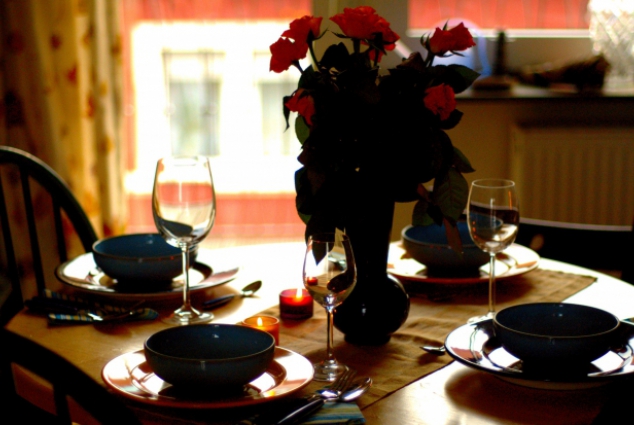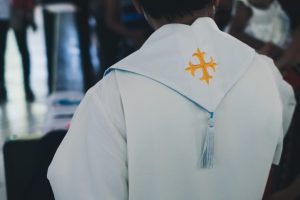The Pastoral Summit project, headed by Paul Wilkes, has been seeking out excellence among Catholic parishes and Protestant congregations since the late 1990s. The following article is excerpted from a book that grew out of the project. Valerie Chapman relates how her parish learned to welcome the poor and homeless at its front door.
One day a man named Bob, who had been living on the streets and under the bridges of Portland, told me he wanted to know more about the church. He had been attending on and off for eight or nine years, and he had been a regular guest in our dining hall, which serves meals to homeless people, new immigrants, the indigent, and the poor.
I encouraged Bob to join our Rite of Christian Initiation for Adults (RCIA) classes, which all people who want to become Catholics attend. RCIA classes come with a lot of handouts about the faith, about Catholic practices, about our social teachings. But Bob couldn’t read.
When he began to take those classes to join St. Francis of Assisi as a full-fledged member, everything I did as a minister was called into question, everything I believed about how to do social ministry had to change.
As Catholics, we had always heard that we need to be disciples, to model Jesus’ ministry in what we do and say to other people. Without much preparation time, this principle had to be put into practice: One member of the group couldn’t read, and another was a professor who taught teachers how to teach students to read. There was no way I could rely on the old standby handouts; the differences were too great.
In the mix something began to happen on several different levels. The catechists had to be prepared to talk about their faith. The learners had to be patient with one another, with all of us respecting the others’ gifts and limitations. And quietly, without the rest of the group knowing, the professor began teaching Bob to read.
Bob attended all the classes faithfully. He listened attentively and at first only spoke when directly asked a question. As the year progressed and he began to feel more comfortable, he ventured to share his own story and his faith with others in the group. His stories of being raised in the Pennsylvania backwoods, of learning to make moonshine with his dad, of traveling across the country by rail were always interesting. His faith was simple and direct. He liked St. Francis Parish because the people did something, rather than just talk about it. He wanted that faith.
As Easter approached, and our new RCIA class was to “graduate” and become Catholics and members of the parish, the St. Francis community had to take seriously the issue of what it meant to have someone who was homeless join our church.
The pastoral council began to discuss the issue officially. Do we baptize this person, then tell him “Goodbye and good luck! Keep warm and well fed”? Or does the gospel call us to do something more radical, like invite him in? And if we give him a place to stay, what will that be like? After living outside for years, will he even know how to take care of his space? Could we, would we, take the risk?
Each year during Holy Week the candidates and sponsors gather for a seder meal. When we gathered that year at our meal, everyone in turn read a part of the service. When it came to Bob’s turn he did not pass as usual. Instead he read and we cried.
When Bob came out dressed in his long white robe, with shaggy long hair, his long beard, and sandals, to be baptized at our pre-dawn Easter service, there was a quiet hush. Bob was immersed, and as he rose from the water the assembly spontaneously rose to their feet. We have never recovered.
Bob had no place to live, and we had a huge former rectory—which is now our parish offices—so we had to face the fact that we had something that someone in our midst needed: a home. Fast-forward five years: Bob has lived in the former rectory since he joined the church. He is our nighttime caretaker.
An uncommon community
I have learned about ministry to the marginalized, embracing that term in all its complexity, by being with people like Bob. As the parish has begun to spend time with those who are homeless, the poor, and the immigrants, and hear their stories, we have realized that they have as much to teach us as we do them. And gradually “us and them” have blended into “we.”
In an even broader sense, I think of my entire parish community as marginal—marginally on the edge of Catholicism. We are the parish people come to when they feel they might not welcome in other Catholic parishes. We are often the first stop back for many recovering Catholics. On any given Sunday eight to 12 former priests are part of the congregation.
A large number of gay and lesbian people are a part of the congregation. We have people who are poor, we have recent immigrants, and we have a substantial middle-class element. Although the parish is predominately Anglo, we have a small but growing number of Hispanics and a handful of other ethnic minorities. About 50 to 60 percent of the community is middle-class professional—mostly social service people with only a few upper middle-class folks, a large group of working-class households, and 10 to 15 percent very poor.
We find common ground for ministering to this wide array of people by basing our church mission on the discipline of hospitality. This means everyone must respect each person, whoever they are, whatever their faith, and whatever gifts or deficits they might have. This can be especially challenging in the neighborhood our church is in.
Half of our parish is bound by a light industrial district. The other half is an aging but up-and-coming residential area. Many of the older homes are divided into apartments. There are people who live in the industrial area s well, but they live in old hotels, apartments above businesses, in shelters (there are three within our boundaries), or under bridges—the parish’s western boundary is Willamette River, and we have four bridges there. The people in the residential neighborhood do not like to claim the industrial-are folks as part of their neighborhood.
We have blended the two divergent communities in our parish-run dining hall, which has been a ministry of St. Francis for almost 22 years. Without the dining hall, we would not be the parish we have become. Our vision is to build a community there, to cross the lines that divide us, be they racial, socioeconomic, or ethnic. The St. Francis community is made up of the 300 people who worship with us on Sunday, the 300 people who eat at the dining hall six days a week, and the people who come by day to St. Francis of Assisi Park.
The park community is diverse, including some ordinary neighborhood folks, but by and large it includes amore transient clientele looking for a safe place to sit for a while without being harassed or told to move on. Many of the “housed” neighbors find the regular park people undesirable. With some effort, the parish has held on to its mission of hospitality and welcomes all who are able to follow the minimal rules. We provide portable toilets and a place to keep shopping carts or bicycles so that the park is not cluttered, and we provide a security presence at peak use times in the year.
Table fellowship
We’ve used several methods to pull our many communities together. When we took over the dining hall, we got rid of the long institutional tables and put in round tables to encourage discussion and get more people talking face-to-face. We invited people from our worship community to be part of the dining hall community, and vice versa.
Of the 300 people in the worship community, the number of people who volunteer is high: 35 to 40 percent. In addition to meal preparation, serving, cleanup, and running classes, games, and activities after the daily lunch in the dining hall, we also encourage people to just come and get to know people: Sit down, have some coffee and conversation.
When people are involved in ministry, they take ownership and help shape what happens. This high level of individual commitment to social justice allows our congregation to take risks. When we celebrated our 125th anniversary, we had breakfast after the Mass with the whole community: the dining hall community, the worshiping community, special guests, and the archbishop—all in one room, undivided—and it worked.
When we have parish social events, we open our doors and invite the poor to come in, too. Members of the community regularly invite some of our poorest members home to have supper or out for coffee. We have learned about addictions and mental illness, and we have learned not to be afraid.
Broadened horizons
Operating the dining hall has radically changed our worshiping community. As we began to listen to the stories of people who come to eat, we discovered that people in these other communities have something to teach us. We deal with people who are drug addicts, mentally ill, recently out of prison, developmentally delayed, new immigrants, and others, and they teach us something every single day.
For example, there are many undocumented immigrants. In hearing stories of life in their countries, I was forced to learn about politics and the resulting effect on the indigenous people of our hemisphere. I shared my learning with the parish, and we began to make a connection with a community living high in the hills of Guatemala.
Eventually I went to study Spanish in Mexico and then went on to Guatemala, to the village we were communicating with. I hand-delivered a gift of money from the parish to a Mayan single mother’s group living far away from many of the conveniences of the modern world. The money was a tithe from a generous gift the parish had received. In the village I met women whose husbands, brothers, or sons were living in the United States earning money to send back home.
I have learned that drug-addicted people are not bad people, regardless of the drugs they do. They are only sick people struggling to live each day without much hope for recovery or kindness in the process.
I have learned not to take good mental health for granted, and I have learned that mentally ill people are real people with real feelings and real needs, hopes, and dreams. I have learned how poorly we as a society prioritize our money, often cutting such important services as drug and alcohol treatment facilities, clean and sober housing, and mental health care. I have learned not to give up trying, even when the system is broken, because people—all people—matter.
If we want to live healthy and holy lives, we can learn from one another. It makes me consider the way I live (Do I have more than my share of this society’s resources?) and how that affects the people who come to the dining hall community and how the way they live, with very few of their basic needs met, affects me.
I wonder, “Can we be in this together?” At St. Francis we have found that when we change, in both our thinking and our actions, people begin to ask us about our faith. We preach with what we do and hope that we do not use too many words.
Practicing hospitality on large and small scales has changed our community. We strive to accept and welcome people right where they are, to listen to their stories, to treat them kindly and with respect. We are fueled by small victories, as we see the fruits of our attempts.
Sam, a man who never spoke, is one of those small triumphs. When I first met him, he slept in the bark dust by the side of the church, where dogs are often tethered. He didn’t smell good. No one knew if he could talk. He wore a number of shabby coats, even in the summer. He was a stereotypical example of the “marginalized.”
I continue to welcome Sam and invite him in. I always spoke to him as if he could talk. Then early one Sunday morning out of the blue he looked at me and said, “Good morning, Valerie.” I was stunned, and for some reason immediately thought of the passage in Isaiah, “I have called you by name.”
I believe we meet God in the marginalized. I hope and pray that we can be Christ for them as well.
This article appeared in the August 2003 issue of U.S. Catholic (Vol. 68, No. 8, pages 24-28).
Image: Flickr cc via Gunnar Grimnes














Add comment